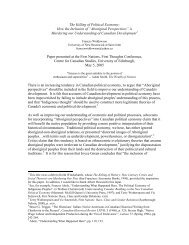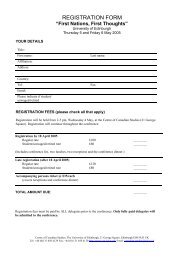Peace, Order and Good Government: Indian Treaties and Canadian ...
Peace, Order and Good Government: Indian Treaties and Canadian ...
Peace, Order and Good Government: Indian Treaties and Canadian ...
You also want an ePaper? Increase the reach of your titles
YUMPU automatically turns print PDFs into web optimized ePapers that Google loves.
<strong>Peace</strong>, <strong>Order</strong> <strong>and</strong> <strong>Good</strong> <strong>Government</strong>:<br />
<strong>Indian</strong> <strong>Treaties</strong> <strong>and</strong> <strong>Canadian</strong> Nation Building 1<br />
Pick up just about any <strong>Canadian</strong> History textbook <strong>and</strong> you are likely to find at<br />
least one reference to “<strong>Peace</strong>, <strong>Order</strong> <strong>and</strong> <strong>Good</strong> <strong>Government</strong>”. This phrase is as much<br />
Canada’s national motto as is “From Sea to Sea”. “<strong>Peace</strong>, <strong>Order</strong> <strong>and</strong> <strong>Good</strong><br />
<strong>Government</strong>” is one of the central themes that we have used to explain the geographic<br />
evolution of Canada. It embodies the idea that our development was largely peaceful,<br />
that our institutions, such as the Mounties, brought justice <strong>and</strong> law to the wilderness<br />
<strong>and</strong> that <strong>Government</strong> has our best interests at heart. This sentiment has become an<br />
important part of the way we identify <strong>and</strong> define ourselves as <strong>Canadian</strong>s. This<br />
identification has evolved because of the way that Canada has grown <strong>and</strong> exp<strong>and</strong>ed<br />
geographically. Like our American cousins, we see the evolution of our country as a<br />
great <strong>and</strong> steady expansion westward. An expansion, however, undertaken through<br />
planning <strong>and</strong> in an orderly fashion that managed to avoid the chaos <strong>and</strong> violence that<br />
took place South of the border.<br />
In our narrative of continental expansion, Aboriginal people are minor players: a<br />
group of people who occupied the l<strong>and</strong> before us <strong>and</strong> who melted into the background<br />
of our national consciousness only rising to attention at a few key moments. This<br />
perception of the role of Aboriginal people in the development of Canada is one that<br />
shortchanges their importance. Their role <strong>and</strong> the way that <strong>Canadian</strong> colonial society<br />
dealt with them has shaped the very nature of our national identity as a peaceful,<br />
accepting people who cherish “<strong>Peace</strong>, <strong>Order</strong> <strong>and</strong> <strong>Good</strong> <strong>Government</strong>” over the<br />
American motto of “Life, Liberty <strong>and</strong> the Pursuit of Happiness”.<br />
Canada’s geographic evolution had as much to do with <strong>Indian</strong> Policy as it did<br />
with the National Policy. Canada’s largely peaceful <strong>and</strong> organised expansion rested<br />
almost entirely on a process of treaty-making that sought to acquire Aboriginal title to<br />
the l<strong>and</strong>. Based on the principles established by the Royal Proclamation of 1763, the<br />
Crown began nearly all of its territorial expansion by signing treaties with Aboriginal<br />
people so as to clear title to the l<strong>and</strong> <strong>and</strong> open up this l<strong>and</strong> to settlement. The<br />
development of regions such as Southern Ontario, Manitoba, <strong>and</strong> the Northwest<br />
Territories were all facilitated by some 70 treaties that surrendered Aboriginal title to the<br />
l<strong>and</strong> in exchange for goods, money <strong>and</strong> long lasting benefits. Coupled with this treatymaking<br />
process, the Crown sought to bring Aboriginal people into the fold of colonial<br />
<strong>and</strong> <strong>Canadian</strong> society. New policies were intended to make <strong>Indian</strong>s into “proper”<br />
Christian agriculturalists <strong>and</strong> therefore removing them as a separate entity within<br />
Canada. To fully underst<strong>and</strong> the role of treaty-making in the <strong>Canadian</strong> Nation Building<br />
exercise, it is necessary to examine early diplomatic process <strong>and</strong> pressures with<br />
regards to treaty -making, to compare <strong>Canadian</strong> <strong>and</strong> American western expansion<br />
experiences <strong>and</strong>, finally, to review Canada’s <strong>Indian</strong> Policy initiatives.<br />
1 The views expressed in this communication are those of the author’s <strong>and</strong> not necessarily those<br />
of the <strong>Government</strong> of Canada.








